
Bittadon is a village, civil parish and former manor in the North Devon district of Devon, England. According to the 2001 census it had a population of 45. The village is about seven miles north of Barnstaple.
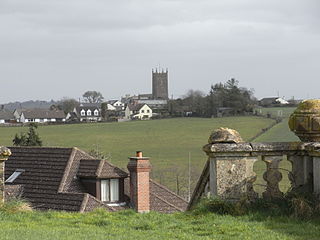
St Giles in the Wood is a village and civil parish in the Torridge district of Devon, England. The village lies about 2.5 miles east of the town of Great Torrington, and the parish, which had a population of 566 in 2001 compared with 623 in 1901, is surrounded clockwise from the north by the parishes of Huntshaw, Yarnscombe, High Bickington, Roborough, Beaford, Little Torrington and Great Torrington. Most of the Victorian terraced cottages in the village, on the east side of the church, were built by the Rolle Estate.

Tristram Risdon was an English antiquarian and topographer, and the author of Survey of the County of Devon. He was able to devote most of his life to writing this work. After he completed it in about 1632 it circulated around interested people in several manuscript copies for almost 80 years before it was first published by Edmund Curll in a very inferior form. A full version was not published until 1811. Risdon also collected information about genealogy and heraldry in a note-book; this was edited and published in 1897.

Colleton is a hamlet and former manor in the civil parish and ecclesiastical parish of Chulmleigh, in the North Devon district of Devon, England. It is situated on the north side of a valley containing the River Taw. Its nearest town is Chulmleigh, which lies approximately 3.6 miles (5.8 km) to the south-west. It consists of the grade I listed Colleton Barton and Colleton Mill, the former manorial mill, with another former industrial building situated at the approach to the bridge over the River Taw.

Stevenstone is a former manor within the parish of St Giles in the Wood, near Great Torrington, North Devon. It was the chief seat of the Rolle family, one of the most influential and wealthy of Devon families, from c. 1524 until 1907. The Rolle estates as disclosed by the Return of Owners of Land, 1873 comprised 55,592 acres producing an annual gross income of £47,170, and formed the largest estate in Devon, followed by the Duke of Bedford's estate centred on Tavistock comprising 22,607 with an annual gross value of nearly £46,000.

Roborough is a village and civil parish 5.5 mi (8.9 km) from Great Torrington. Situated topographically on the plateau between the Torridge and Taw Rivers, the parish covers 1,258 ha and contains a population of some 258 parishioners. It is surrounded by a pastoral landscape of rectangular fields, high hedges and scattered farmsteads.
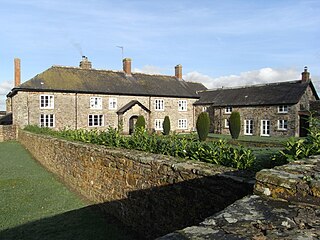
Brightley was historically the principal secondary estate within the parish and former manor of Chittlehampton in the county of Devon, England, situated about 2 1/4 miles south-west of the church and on a hillside above the River Taw. From the early 16th century to 1715 it was the seat of the Giffard family, whose mansion house occupied the moated site immediately to the west of the present large farmhouse known as Brightley Barton, a Grade II listed building which incorporates some elements of the earlier house. It is not to be confused with the 12th-century Brightley Priory near Okehampton.
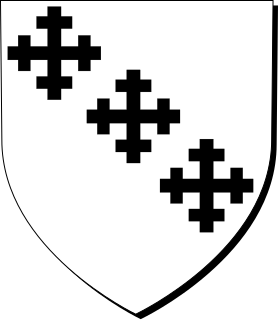
.
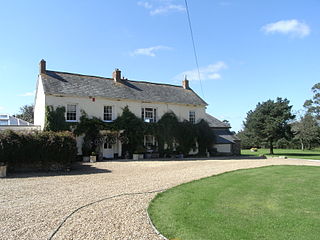
Way is a historic estate in the parish of St Giles in the Wood, Devon. It is situated about 2 miles north-east of the village of St Giles in the Wood and about 4 miles north-east of the town of Great Torrington. It was described by Hoskins (1959) as "the fons et origo of the mighty tribe of Pollard" and had been acquired by them from the de la Way family at some time before 1242.

Langley was a historic estate in the parish of Yarnscombe, Devon, situated one mile north-east of the village of Yarnscombe. It was long the seat of a junior branch of the Pollard family of Way in the parish of St Giles in the Wood, Devon, 3 miles to the south.
Matford is an historic estate in the parish of Alphington, near Exeter, Devon. It should not be confused with Matford in the parish of Heavitree, almost immediately opposite on the other side of the River Exe.

Bableigh is an historic estate in the parish of Parkham in North Devon, England. It is separated from the village of Parkham by the Bableigh Brook. It was the earliest recorded seat of the Risdon family in Devonshire, from which was descended the Devon historian Tristram Risdon.

The Manor of Copleston was a manor in the parish of the parish of Colebrooke in Mid Devon, England, now centred on the village of Copplestone.

Sharpham is an historic estate in the parish of Ashprington, Devon. The Georgian mansion house, known as Sharpham House, overlooks the River Dart and is a Grade I listed building. The house was commenced in about 1770 by the Royal Navy captain Philemon Pownoll to the designs of the architect Sir Robert Taylor (1714–1788). In the opinion of Nikolaus Pevsner it contains "one of the most spectacular and daring later 18th century staircase designs anywhere in England". The park and gardens are Grade II* listed in the National Register of Historic Parks and Gardens. Part of the descent of Sharpham is shown on the Palmes family heraldic pedigree roll.
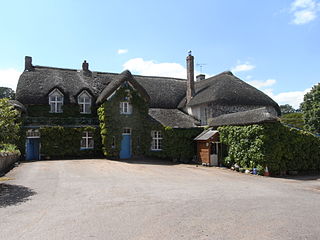
Spencer Combe in the parish of Crediton, Devon, is an historic estate. The grade II listed farmhouse known today as "Spence Combe", the remnant of a former mansion house, is situated 3 miles north-west of the town of Crediton. Spencer Combe is given in several traditional historical sources as the seat of Sir Robert Spencer (d.pre-1510) who married Eleanor Beaufort (1431–1501), the daughter of Edmund Beaufort, 2nd Duke of Somerset (1406–1455), KG, and who was father to two daughters and co-heiresses who made notable marriages. The arms of this Sir Robert Spencer were Sable, two bars nebuly ermine, as shown in the Percy window in the chapel of Petworth House and as quartered by Cary, Viscount Falkland. The American genealogist Douglas Richardson suggests however that Sir Robert Spencer was in fact the son and heir of John Spencer, Esquire, MP for Dorset, of Frampton in Dorset, Ashbury in Devon and Brompton Ralph in Somerset, by his wife Jone. The arms given by Pole for Spencer of Spencer Combe, are: Argent, on a bend sable two pairs of keys or, and are shown quartered by Prideaux on the monument in Farway Church, Devon, to Sir Edmund Prideaux, 1st Baronet of Netherton Hall, and are shown in stained glass impaled by de Esse of Thuborough in the Thuborough Chapel of Sutcombe Church.

The large parish church of St Giles, which is in the village of St Giles in the Wood, Devon, England, came into being in 1309. When it was restored in 1862–3, many monuments were retained, including the monument and effigy of Thomas Chafe of Dodscott, three monumental brasses, of Alenora Pollard, Margaret Rolle of Stevenstone and a small brass of her husband John Rolle (d.1570). There are also 19th- and 20th-century monuments to the Rolle family.

Canonteign is an historic tything in the parish of Christow, near Chudleigh, in South Devon, England and situated in the valley of the River Teign. It belonged to Merton Priory in Surrey, founded in 1117 by King Henry I for the Black Canons (Augustinians). It is best known today for the Canonteign Falls waterfall. Canonteign today contains three significant houses: the original Grade I listed 16th-century manor house, the ancient barton house situated nearby behind a granite wall, and a new mansion house built by the Pellew family in the early 19th century nearby, to which that family moved their residence thereby abandoning the old manor house.

Sir Hugh Stucley (1496–1559) was lord of the manor of Affeton in Devon, and was Sheriff of Devon in 1545. His third son was Thomas Stukley, known as "The Lusty Stucley".
The manor of Alverdiscott was a manor situated in north Devon, England, which included the village of Alverdiscott.

Speccot is an historic estate in the parish of Merton in Devon, England. It was the seat of the de Speccot family, one of the oldest gentry families in Devon, which founded almshouses at Taddiport, near Great Torrington, Devon, in the 13th century. It is situated about one mile south-west of Potheridge, the seat of the Monck family from before 1287 to the late 17th century, who were thus close neighbours of the de Speccot family for many centuries. The present farmhouse known as "Speccot Barton" is Victorian and although no obvious traces of an earlier house survive, is marked "On Site of a Mansion" on the First Edition Ordnance Survey 25 inch map of 1880-99. The estate is today operated as a family-run sheep farm with six holiday cottages to let. A smaller house known as "Little Speccot" is situated on the approach lane to Speccot Barton.


















